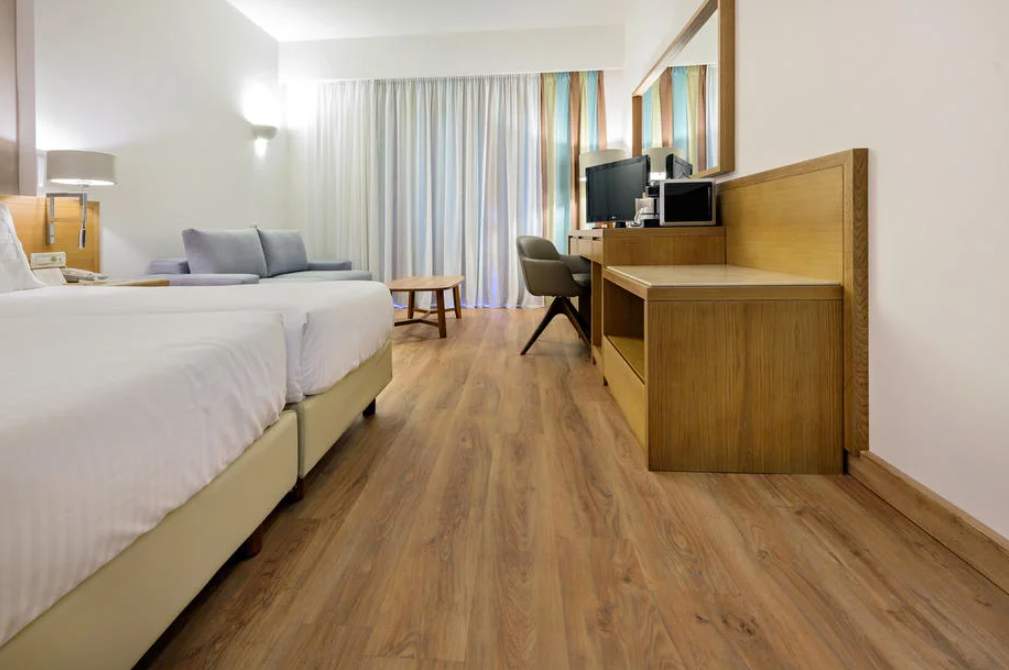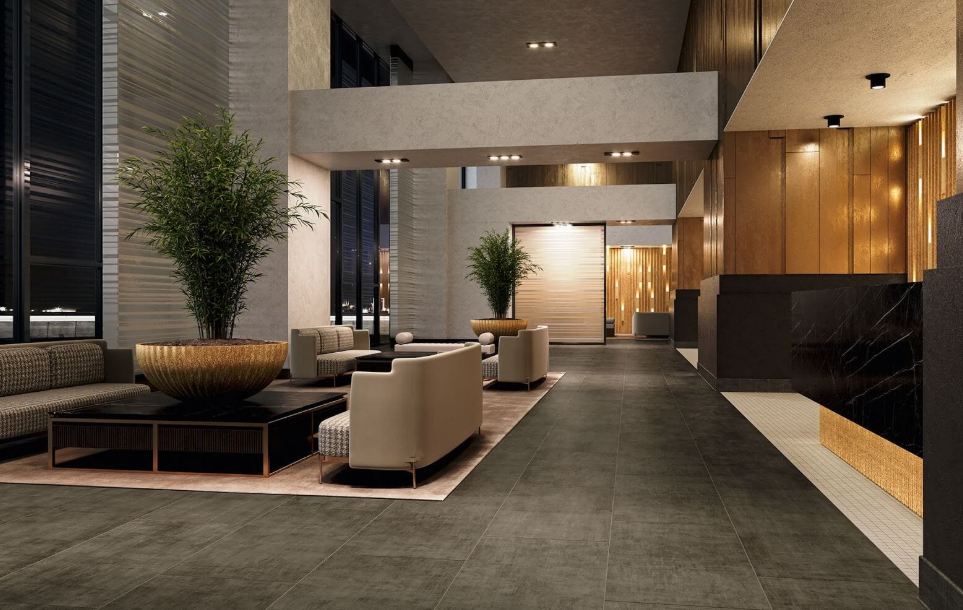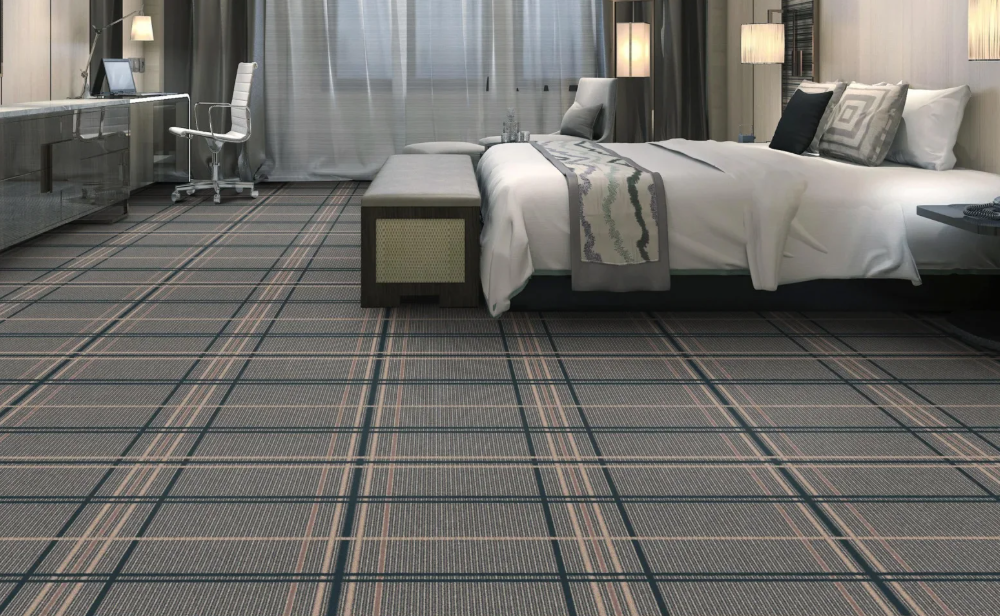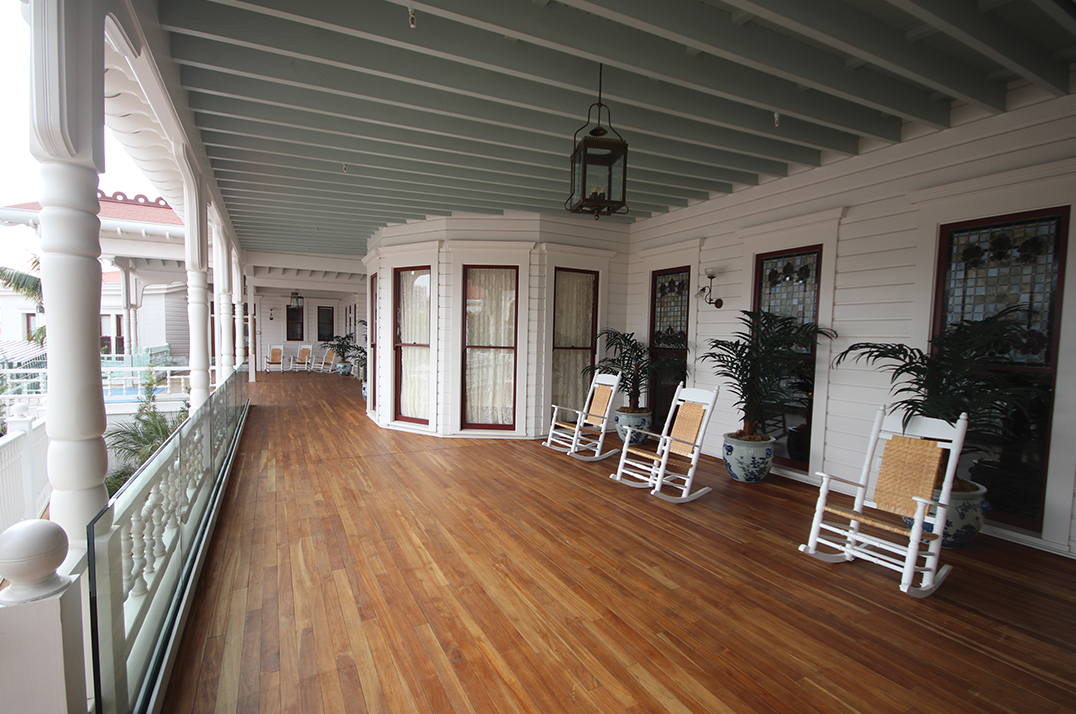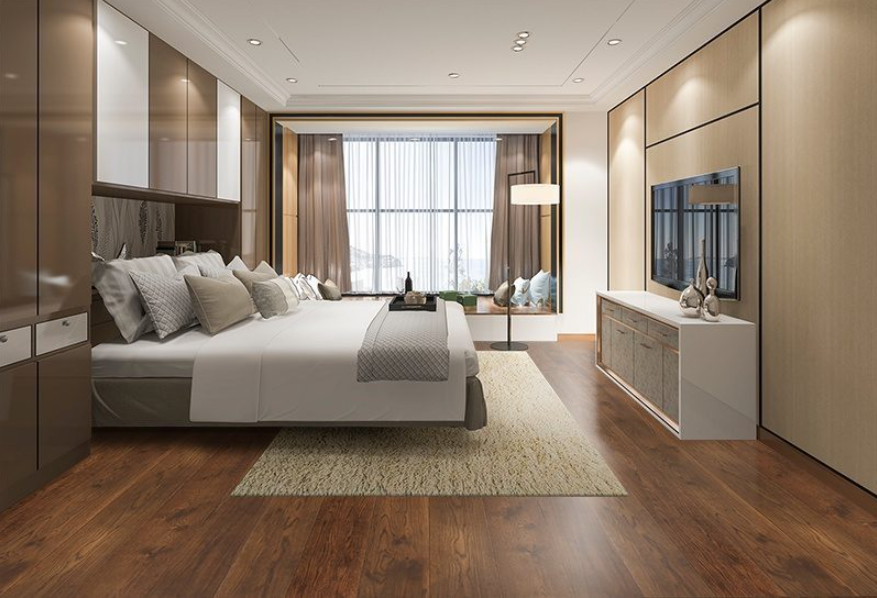Introduction: What Hotel Room Flooring Needs from Flooring Suppliers in 2025
For 2025, the best hotel flooring needs the right mix of durability, style, and sustainability. I see more designers choosing natural, warm materials. These create a welcoming feeling for guests. They also hold up well against heavy foot traffic and everyday wear.
Wood and wood-look flooring are very popular. I recommend styles with wider planks, chevron layouts, or large patterns. These floors are both stylish and practical. Choices like brown-stained oak, smoked oak, and black-stained ash show a move to rich, dark hues.
These colors add a touch of luxury and warmth. I’m also seeing a shift to earthy and natural tones. Honey oak, clay, and terracotta are popular. They create a relaxed feel and are replacing cooler grays and whites.
If moisture is a concern, I suggest using wood-look vinyl flooring in these popular shades. It’s simple to clean and comfortable for guests. It also keeps its finish, even in damp rooms.
LVP & LVT Flooring for Hotels: Durable, Waterproof, and Built for Style
From my experience, I see LVP and LVT becoming the top flooring choice for hotels in 2025. They offer a great mix of strength, style, and value.
Durability & Longevity
Recommend looking for high-quality LVP/LVT with a wear layer of at least 20 mil. This thickness is built for hotel life and stands up to heavy foot traffic, moving furniture, and even pet claws.
Both LVP and LVT are 100% waterproof. This makes them a reliable choice for areas with high moisture, like bathrooms or kitchens. You won’t have to worry about the floors warping or swelling.
For 2025, I suggest looking at top brands like Proximity Mills, Canopy Floors, Mohawk, and Baier. They use advanced core technology and surface treatments. These features guard against scratches, dents, and stains, which helps the flooring look good despite constant guest use.
Guest Comfort & Aesthetics
LVP/LVT feels softer, warmer, and quieter underfoot than ceramic or stone. Many commercial products I’ve seen include a built-in sound-absorbing underlay, which makes a real difference.
Modern printing creates realistic wood and stone looks. These visuals add a sense of luxury that fits well with contemporary hotel designs without giving up performance.
Hotel operators value LVP/LVT for its ability to reduce noise transmission. This is a key benefit in multi-story properties where guest comfort is a main priority.
Maintenance & Cleaning
The flooring is stain-resistant and easy to care for. Routine sweeping and mopping are all you need. I like that the surface never needs waxing or refinishing.
Spills clean up quickly. The water- and stain-resistant finish helps prevent permanent marks. This simplifies room turnover and saves time for your housekeeping staff.
Simple maintenance means less downtime for rooms. This results in faster guestroom availability and fewer disruptions for hotel operations.
Cost & Installation Advantages
LVP/LVT gives you the look of hardwood or stone for a lower cost. Based on my experience, engineered hardwood averages $8–$12 per square foot installed. Premium LVP averages $3–$6 per square foot. With contract or bulk orders, some options can even fall below $3 per square foot.
Installation is easy and fast. I recommend click-lock and floating floor options. They can be installed up to 40% faster than tile or wood. This reduces labor costs and shortens downtime during any upgrades.
The long-term costs are low. You’ll have fewer repairs and simple upkeep. With an average lifespan of 10–20 years in hotels, I believe LVP/LVT is a smart investment.
Porcelain Tile for Hotels: Durable, Elegant, and Marble-Look Ready
I think porcelain tile is a top pick for hotel room floors in 2025. It’s very strong and lasts for many years. Based on my experience, it handles the daily grind of heavy foot traffic and regular cleaning routines in busy hotels.
Great Durability & PEI Ratings
To check how durable a porcelain tile is, we use the Porcelain Enamel Institute (PEI) rating system. For hotel rooms, I recommend choosing tiles with a Class 4 or Class 5 PEI rating.
Class 4: Handles heavy foot traffic in homes and medium traffic in businesses. I find it’s perfect for busy hotel rooms and hallways.
Class 5: This is the strongest class, designed for places like airports. These tiles hold up against scratches, stains, and water.
With this kind of strength, you’ll have fewer worries about wear. Your hotel spaces will stay looking new for years, even with lots of guests.
Current Styles: Wood-Look & Marble-Look Porcelain
One of the best things about porcelain in 2025 is its wide range of styles. It can mimic the look of wood and marble. This gives hotels a high-end visual without the difficult maintenance.
For instance, I like the Antoni Café Porcelain Wood Tile. It has warm coffee tones and a rustic grain. It adds a charming, welcoming feel, and you don’t have to stress about water or scratches.
Marble-look porcelain with its soft veining makes a room feel peaceful and upscale. I believe it’s a perfect fit for luxury suites.
Popular colors are modern and light, like Cabana Blonde. You can use it to design fresh, minimal, or even dramatic rooms that match your hotel’s brand.
I’ve also seen patterned styles like “kit kat” or “Maiolica” being used. They look great in bathrooms or as room accents to make a guest’s stay special.
Maintenance, Hygiene & Guest Comfort
Porcelain has a low water absorption rate, so it resists stains and mold. I find this makes it a very hygienic choice, especially for hotels with strict cleaning rules.
Regular cleaning is straightforward. You may need to do some grout maintenance from time to time to keep things looking crisp, but the tiles themselves are simple to care for.
To improve guest comfort, I’ve noticed many upscale hotels are installing radiant underfloor heating under their porcelain tile. This takes away the cold feeling from the floor and really improves the guest’s experience.
Commercial Carpet & Carpet Tiles: Acoustic Comfort and Durable Style for Hotels
For hotel rooms in 2025, I recommend commercial carpet and carpet tiles. They offer a great mix of strength, style, and comfort. In my experience, hotel designers choose high-performance nylon carpets. They hold up very well to heavy foot traffic and stains, which is essential for any busy hotel. These carpets have special coatings to block food and drink spills. Plus, the synthetic fibers bounce back fast after heavy furniture is moved.
Durability Ratings and Performance Standards
To get the best performance, I suggest you check the EN/ISO ratings for commercial carpets:
– Class 31: Great for light-traffic areas like hotel rooms and small meeting spaces.
– Class 32: A good fit for medium-use areas such as hotel restaurants and offices.
– Class 33: Made to handle heavy traffic in public areas like hotel hallways, lobbies, and casinos.
From my perspective, premium Axminster carpets are the gold standard for luxury hotels. They are very strong, last a long time, and feel soft and quiet to walk on.
Design, Guest Comfort & Acoustic Benefits
The carpet you choose greatly affects how happy your guests are:
– I find that operators pick soft carpets for comfort. They also provide great sound insulation, which makes rooms and hallways much quieter.
– Boutique and flagship hotels often invest in custom carpets. These designs can reflect local art or the hotel’s brand, creating a lasting impression.
– For city hotels, acoustic-performance carpets are a top priority. I’ve found they are excellent for reducing noise from rolling suitcases and footsteps.
Laminate Flooring for Hotels: A Smart, Stylish, and Cost-Efficient Solution
For hotel rooms in 2025, I think laminate flooring is an excellent choice. It gives you great scratch resistance and affordable installation. You also get a wide range of styles. If you need to balance cost and performance, I suggest you consider laminate for your guest rooms.
Scratch Resistance & Durability
Top-Notch Scratch and Dent Resistance: Laminate holds up to scratches better than LVP. It is also very difficult to dent, even with heavy hotel furniture.
Abrasion Class (AC) Ratings: I recommend choosing an AC4 or AC5 rating for busy hotel areas. This rating guarantees the floor has commercial-grade strength and will look good for a long time.
Water Resistance & Where to Use
Many new laminate products come with water-resistant cores and tight-locking systems. Keep in mind that most laminate flooring is not 100% waterproof.
To prevent warping, I advise against using standard laminate in wet areas like bathrooms or entryways. A strategy I’ve seen work well is to use laminate in guest rooms and pair it with LVP or tile in the wet zones.
Sound, Comfort & Guest Experience
Laminate feels softer and warmer on your feet than porcelain or stone. It’s firmer than carpet or LVP.
I recommend using a high-quality underlayment. This will make the floor more comfortable and absorb more sound, which helps guests feel relaxed.
It absorbs a moderate amount of noise. This is better than hardwood or tile and helps keep rooms quieter.
Style & Appearance
Modern technology makes laminate look just like real wood, stone, or tile. Hotels can pick from many styles, plank widths, and finishes.
In my opinion, this makes it simple to match your hotel’s brand. You can get the look of expensive hardwood or stone without the high price tag.
Maintenance & Care
I find that laminate is simple to clean, and it resists stains. All you need to do is sweep or damp mop it each day.
Be careful with excess water. Standing moisture can damage even the best laminate if it’s not a water-resistant type.
If a plank gets damaged, you can replace just that one piece. This saves time and money on repairs.
Environmental & Safety Standards
Most commercial laminates sold in 2025 have to meet strict limits for formaldehyde and VOC emissions. I like this because it leads to better indoor air quality for both guests and staff.
Lifespan in Hotel Settings
If you install it correctly and control moisture, I’ve seen commercial-grade laminate last 10–15 years in hotel rooms.
I suggest pairing it with waterproof flooring in other areas. This protects your investment and ensures good performance.
I believe laminate flooring is one of the smartest choices for a hotel. It helps you get the most durability, guest satisfaction, and value. I find it works best in guest room areas.
Engineered Hardwood Flooring for Hotels: Luxury Meets Long-Lasting Durability
Based on my experience, I recommend engineered hardwood for high-end hotel rooms in 2025. It gives you the beautiful look of real wood and is also strong enough for commercial use.
Durability & Longevity
With good care, it lasts 20–30+ years, which is similar to solid hardwood.
Its layered build adds stability. This means it won’t expand or warp as much with temperature changes in a hotel.
You can refinish it multiple times thanks to the thick top layer. This extends its life.
New finishes protect the floor. I’ve seen great results with matte, oil-based, and scratch-resistant coatings that stop scuffs, dents, stains, and water. You can also spot-treat busy areas to keep them looking new.
I suggest looking for products that meet Class 33 commercial durability standards. This shows they are tough enough for hallways, guest rooms, and suites.
Case Study: The Conrad Evermore Resort in Orlando is a great example. They used an engineered hardwood from Cambodia as a floating floor. I think this was a smart choice. It gave them a luxury look, easy cleaning, and great value over time.
Guest Experience & Aesthetics
The top layer is real hardwood. Guests will feel the warmth and see the authentic wood grain. I believe this makes a room feel more premium.
You have so many choices. It comes in different wood types, finishes, colors, and plank sizes. You can find wide planks for a modern look or narrow ones for a classic feel.
From my observations, it also absorbs some sound. This makes rooms quieter and more comfortable than floors with harder surfaces.
The look and feel of real wood can be a selling point. I’ve seen hotels charge higher rates and get better reviews because of it.
Easy Maintenance & Cleaning
Routine sweeping, vacuuming, and occasional mopping keep the floor ready for each new guest.
Unlike carpet, it doesn’t trap dust, moisture, or smells. This means better air quality and a cleaner room.
You can do spot touch-ups with modern finishes. I recommend using oil-based treatments to easily fix any small signs of wear.
A simple refinish is much cheaper than replacing the entire floor. It keeps the rooms looking fresh for years.
Summary: What Works Best for Hotel Flooring in 2025
In 2025, hotel flooring is really about finding the right mix of style, durability, and cost control. For most guest rooms and busy hallways, LVP flooring is a top pick—it’s tough, looks great, and doesn’t break the budget.
If you’re going for a high-end feel, engineered hardwood flooring is the way to go. It lasts a long time and works well in premium hotel suites. Want to keep things quiet while adding some bold design? Patterned commercial carpets do both.
For hotel lobbies and bathrooms, a lot of buyers are choosing porcelain tile or terrazzo flooring. These materials are durable and bring a clean, upscale look.
We’re also seeing more wide plank floors, natural tones, and interesting textures being used. A lot of mid-range hotel brands are upgrading fast with these trends.
Bottom line—if you’re sourcing hotel flooring in bulk, pick something that looks good and lasts. That way, you impress your guests and save on future repair costs. It’s a smart long-term move for any hospitality project.

